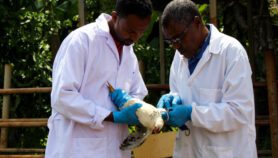Send to a friend
The details you provide on this page will not be used to send unsolicited email, and will not be sold to a 3rd party. See privacy policy.
Much has been said and written recently about the concept of ‘systems of innovation’, usually taken to describe the procedures and institutions needed to ensure that scientific results are able to contribute to social and economic development. Much of the discussion around such systems, however, strikes me as pretty thin soup — or, to put it in terms of another food metaphor, appears to be putting some old wine in new bottles.
In the case of agricultural research, for example, much of what is being proposed under the banner of ‘systems of innovation’ has in fact been done for some time, though not with the same label, and perhaps with a reduced scope.
Admittedly, the degree to which it has been possible to put this approach into effect reduces as one moves to the poorest nations, partly because such nations lack the resources to implement some of the individual components that are necessary for innovation systems to be effective.
But there is also a danger that such systems, which sometimes sound like development programmes in themselves, could obscure and diminish the vital role of underlying scientific research and development. This tends to be confirmed by some of the statements in SciDev.Net’s policy brief on this topic, where it is stated that the adoption of systems of innovation is useful is that it “shifts attention from scientific and technical inputs — such as research and development activities” (see The ‘system of innovation’ approach, and its relevance to developing countries).
The ‘innovation systems’ concept may well be a useful additional dimension to policymaking at the country level. But to suggest downplaying the significance of what little research there is in developing nations seems premature, and could carry substantial opportunity costs. The real need is to build up support and funding for the other components of innovation systems as they prove of value.
The tendency to diminish the importance of scientific research is accentuated when proponents of ‘innovation systems’ and others caricature the science and technology innovation process by referring to what is often described as the ‘outmoded linear process’.
This seems to suggest that the process has in the past been entirely one way, and that there have not been important feedback loops. It also downplays the continuing role of science in helping fuel technological development. Neither inference is justified, particularly for the bulk of agricultural research, but perhaps also more generally.
Furthermore, reference is frequently made to the need for a more ‘bottom-up’ approach in setting priorities. In particular, this tends to be cast in the larger framework of ‘top-down’ (scientist-determined) versus ‘bottom-up’ (farmer-determined) priority-setting.
In reality, however, neither is sufficient on its own; the challenge is to develop an appropriate blend of both groups, as well as involving others. Within such a context, scientists can both contribute a perspective of what is possible, and learn from the process; the interaction is good for society, and good for science. This is so even despite the fact that the priority-setting and resource-allocation process for publicly funded research is, of course, partly a political process — and may not always represent the most efficient allocation of resources.
Finally, the innovations systems approach also seems to overlook the ‘public goods’ dimension of research – the relative degree to which research programmes provide socially and scientifically important and useful public goods (i.e. goods that are not depleted by use, and remain available to all).
Much of the current economic rhetoric is cast in terms of claiming that pure public goods are — as a result of growing linkage with the private sector — increasingly becoming ‘impure’ goods, since they are restricted in their availability. This is not necessarily bad; indeed it may well result in an enhanced product and greater benefits for society. But it is also not necessarily true.
Since public goods exist at all levels — global/international, regional, national, and local — it is important to develop a process for determining priorities and allocating funding that is appropriate at each level. A procedure that is appropriate at the local level, for example, and focuses on relatively short-term and applied research, may be quite inappropriate at the global level, where the need is to focus on widespread problems, and on the generation of scientific knowledge that can be used in many nations.
Maximizing research ‘spillover’ — their flow or spread from one area to another — is an important step in the process. Thus the participants in the process, and the relative weights given to various factors, may well vary, depending on geographic scope. One process seldom fits all situations.
The public goods perspective is not yet common in science. But it has been given increasing attention by the Consultative Group on International Agricultural Research (CGIAR) since 1990, and is emphasised in current priority-setting process by the CGIAR’s Science Council. It might be well if it were given greater attention by other groups concerned with science policy and research priorities, and in thinking about innovation systems as a component of policymaking in this field.
Just as the process of implementing innovation systems involves wide dialogue, so should the question of their design, scope, and balance. So far we seem to have had more of a bandwagon of endorsements than critical analysis and discussion.
The author is senior research advisor and agricultural economist at the Office of Environment and Science Policy in the US Agency for International Development (USAID). These remarks were made in a personal capacity.












